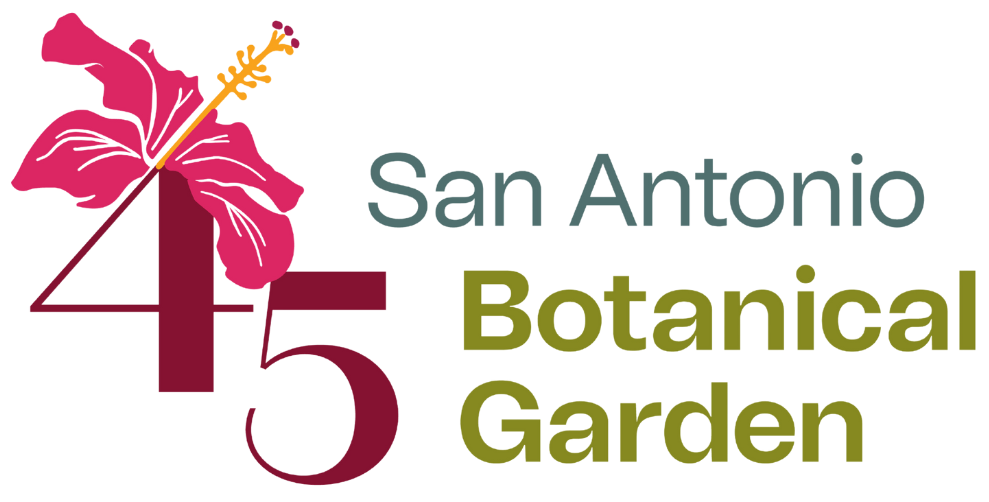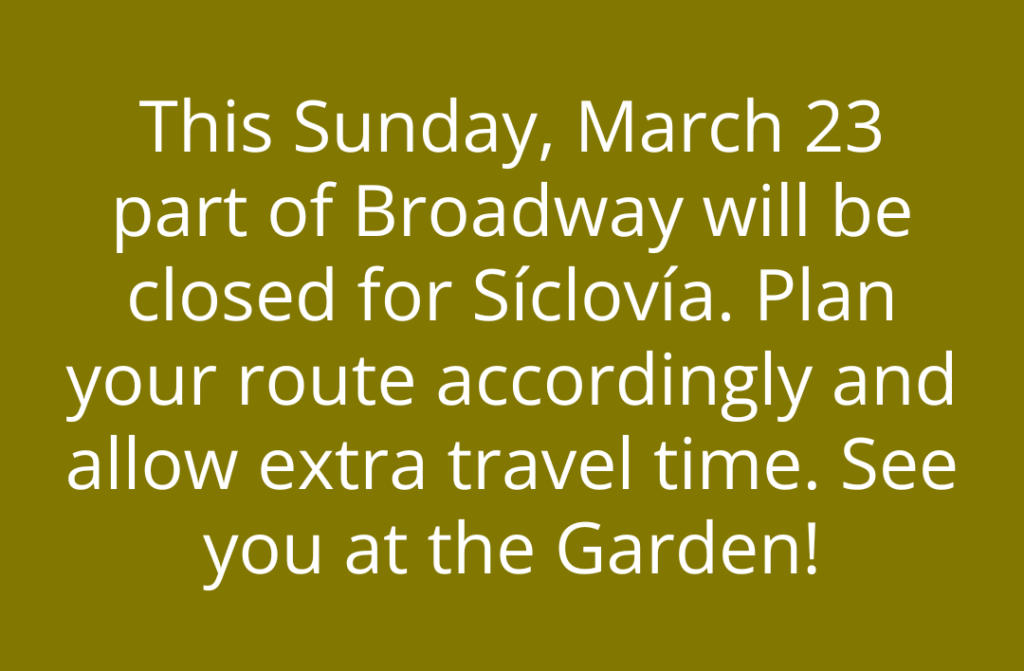Featured Attractions
Explore the Gardens, Trails, and Historical Structures
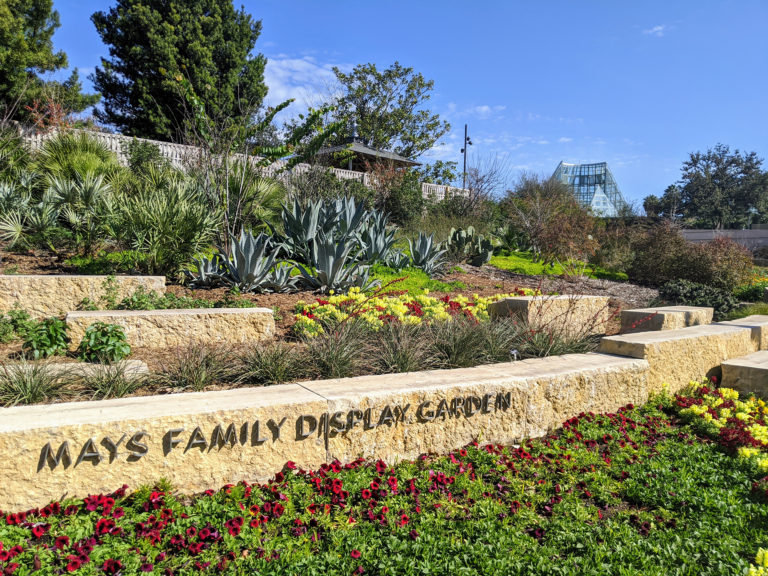
This diverse, ever-changing showcase of color, texture, and fragrance celebrates the rich possibilities of horticulture in South Central Texas. Seasonal plantings illustrate compositions and act as a living curriculum whether for both the amateur and professional gardener.
Featuring an abundance of show-stopping native and adapted plants, the Mays Family Display Garden dazzles guests with hot and energetic color schemes that celebrate the heritage of San Antonio. A gentle waterfall brings a refreshing element to the space and provides the tranquility richly deserved for the cherished Kumamoto En Japanese Garden nearby.
Goldsbury Foundation Pavilion
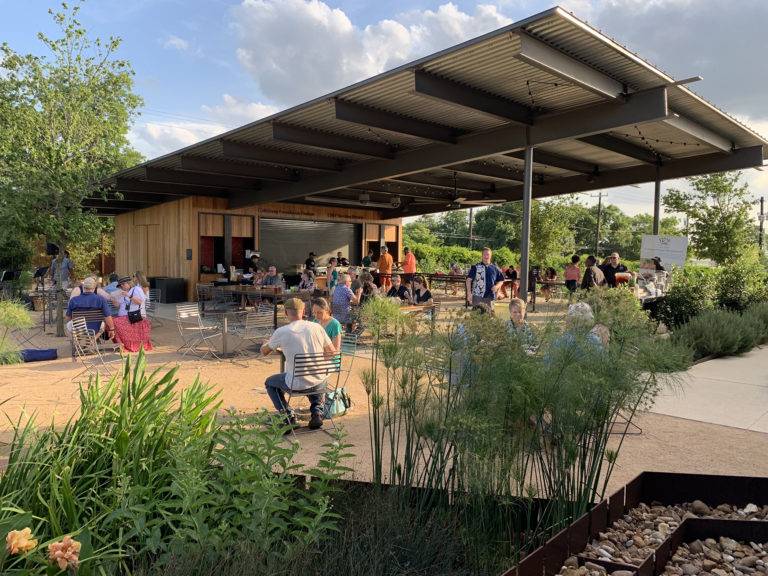
Comprised of the Zachry Foundation Culinary Garden and the CHEF Teaching Kitchen in the Goldsbury Foundation Pavilion, this area of the Botanical Garden offers a garden-to-table experience that deepens the connections between gardening and healthy cooking. The Culinary Garden is a 34-bed space highlighting the message that Good Food Grows. This engaging garden showcases not only the tantalizing staples of healthy eating – it invites guests to participate in planting, harvesting, and preparation. Fresh vegetables, herbs, and fruits will be cultivated year-round, engaging young and old in the art and science of gardening.
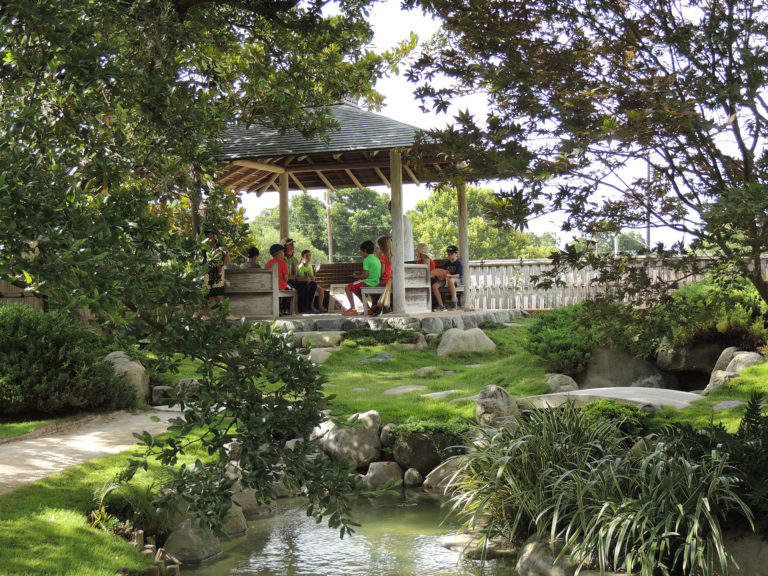
A gift to San Antonio in 1989 by its sister city, Kumamoto, the Kumamoto En (En means garden in Japanese) is an authentic Japanese Garden designed by landscape artists and craftsmen from Japan. In exchange, San Antonio gave Kumamoto a log cabin from the Hill Country town of Fredericksburg.
Designed by the Emperor’s gardener (and corporate CEO) Kiyoshi Yasui, this 85’ x 85’ garden is modeled after one at the Emperor’s summer house — which required special permission. The pond symbolizes the Pacific Ocean that separates the East and West. The west side of the garden honors Mt. Fuji, the center hill Mt. Aso (near Kumamoto), and with its oak trees, the east side of the garden is a nod to the Texas Hill Country. Don’t miss this haven of rustic simplicity and peace featuring more than 30 elements of a classic Japanese garden, including stone walks, unique water elements, granite lanterns, and bamboo fences.
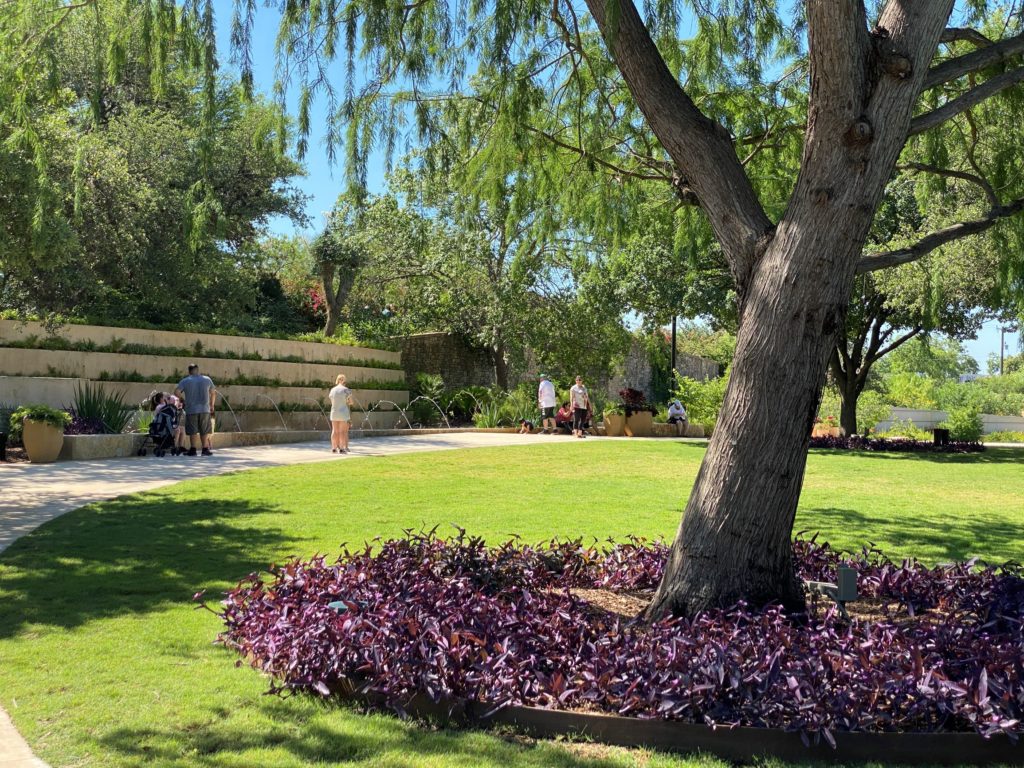
Surrounding the Botanical Garden’s 3500sf, flagship The Betty Kelso Center, the Greehey Lawn can accommodate a sit-down dinner up to 700 guests or a festival for 1,000 of your closest friends. This lush, highly desirable outdoor setting includes a Circle Bar Foundation Wisteria Arbor surrounded by mature live oak trees and a limestone paved plaza, accented by the peaceful sounds of gently running water from the nearby John L. Santikos Fountain of the Ferns.
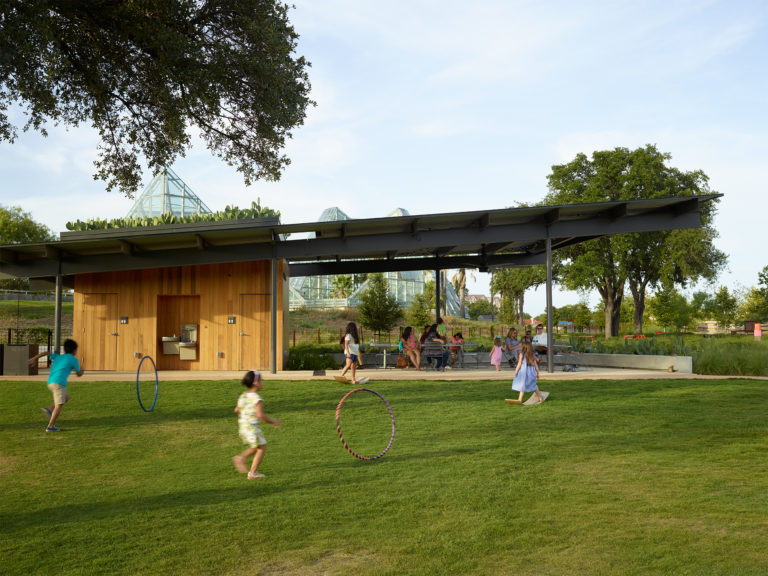
Did you know that today’s children spend only 4-6 minutes a day engaged in outdoor play? At the Family Adventure Garden, it’s time to run, roll, climb, and splash those wiggles away. With 15 galleries representing urban San Antonio, the Hill Country, and South Texas, this 2.5-acre nature space invites children and their families to “come mess with Texas.” Kids are encouraged to get hands-on with nature – to climb, tumble, stretch their limbs and their imaginations — while learning about the story of water (aquifer recharge), ecology, and environmental stewardship.
Thunder Ridge appeals with its spontaneous thunderstorm spilling into No Name Creek (offering seasonal splashing opportunities). Dry Rock Creek and Cypress Spring feature a winding dry creek bed to play with rocks, sand, sticks, and plants — while demonstrating the ecology of the South Texas Plains. The Backyard Explore is a place where kids learn about the soil, sand, plants, insects, and animals found in a backyard environment. Huisache Way is a wooded nature play zone that includes materials for building and playing in forts, using nature as an artistic canvas, engaging in outdoor acoustic and sensory experiences, dramatic play, and constructing with loose natural parts. Semmes Prickly Pear Peak with its Bluestem Bluff and Limestone Ledge mimics the Texas Hill Country and entices youngsters to get physically active. Muhly Maze invites problem-solving exploration, while the Prickly Pear Pavilion offers space for birthday parties, playgroup meetups, and other gatherings.
Kids will love romping through these 15 fun spaces that encourage imaginative, unstructured outdoor plan and exploration — while parents and caregivers will find plenty of places for resting and socializing.
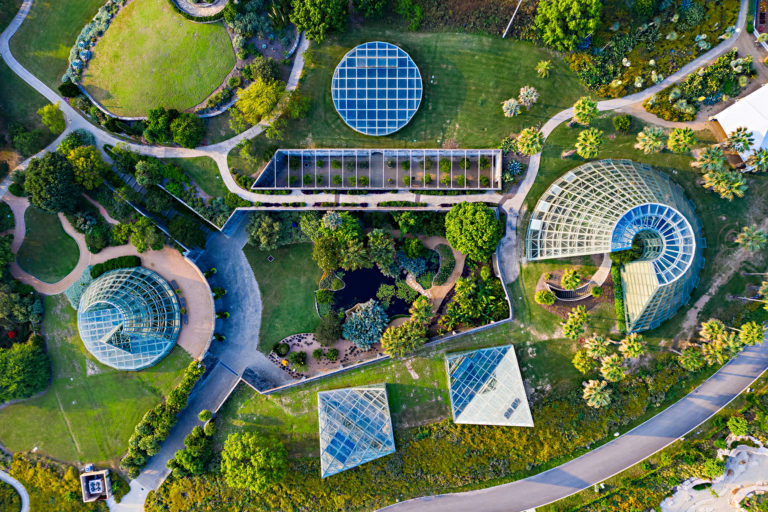
The striking, internationally renowned Lucile Halsell Conservatory is a 90,000 square foot complex featuring five futuristic glass structures housing tropical palms, rainforest ferns, desert cacti, and rare orchids, which surround an inner courtyard, orangerie, and pond. Discover plants from the tropical rainforest and its canopy to the deserts of Mexico and South Africa, as well as tropical palms and ancient ferns.
Both timeless and specific, natural and man-made, the Lucile Halsell Conservatory changed San Antonio’s skyline in 1988. Designed by Emilio Ambasz, the iconic Lucile Halsell Conservatory has welcomed millions of guests looking to explore unique plants and ecosystems from around the world. Capturing the 1985 Progressive Architecture Award, the 1988 National Glass Association Award for Excellence in Commercial Design, and the 1990 First Place Quaternario Award, the Lucile Halsell Conservatory complex’s Palm and Cycad Pavilion soars 65’ high at its tallest point and cradles the Fern Grotto 23’ below the earth’s surface. Be sure to explore all the Lucile Halsell Conservatory’s amazing spaces:
Exhibit Room – The epiphyte exhibit features orchids, bromeliads, and other plants found in a tropical rain forest canopy. While epiphytes exist by growing on another plant, they are not considered parasites.
Robert and Helen Kleberg Desert Pavilion – This exhibit showcases plants from the deserts of Mexico and Southern Africa. These hardy species survive through adaptations such as having thick succulent stems and leaves to store water, lack of leaves to slow water loss, spines instead of leaves, or reflective coatings of thick hairs.
Gretchen Northrup Tropical Conservatory – Half of the world’s plants and animals live in tropical rain forests. Since light is limited, plants must grow tall, grow large leaves, and climb or attach themselves high up in the branches of tall trees in order to reach the light. Cocoa, coffee, and rubber trees are all examples of tropical rainforest natives.
Palm and Cycad Pavilion – Cycads are relics of the Carboniferous Age (dinosaur times), and this display features the Queen Sago (tallest cycad), Lata Palm, and Coconut Palm. In the tropics, these useful plants provide food, shade, building materials, fuel, and clothing.
Fern Grotto – Some of the oldest living plants are found in this exhibit, dating even further back than the Cycads. When ancient ferns died, they became the great coal and oil deposits that today’s world uses to obtain energy.
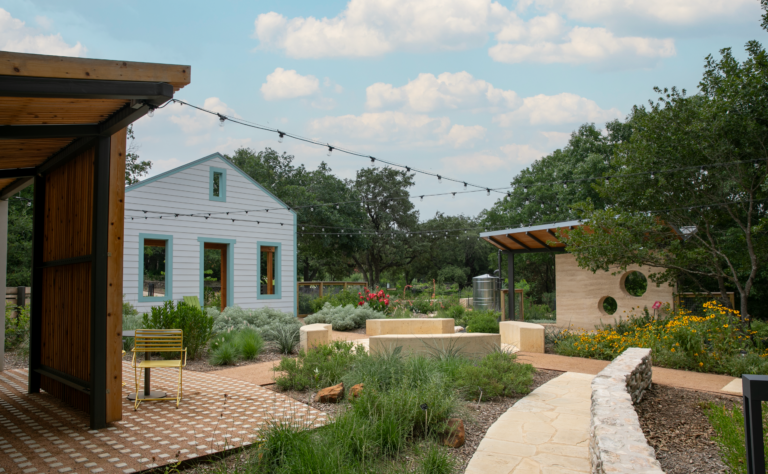
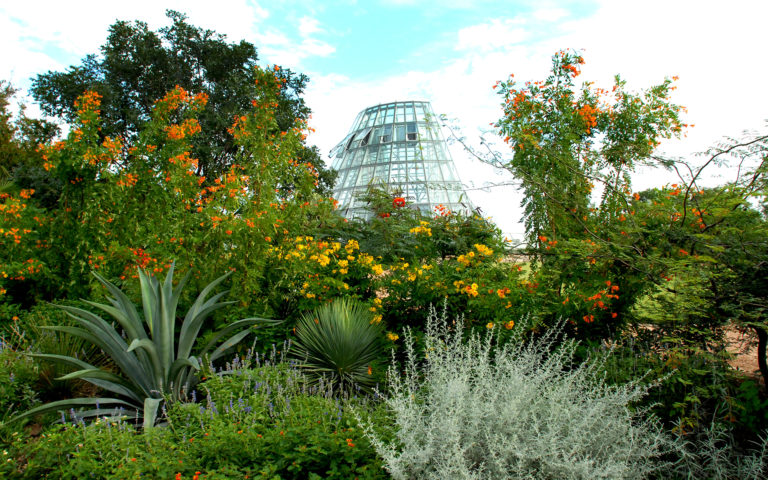
In December of 2023, the newly remodeled WaterSaver Community, formerly WaterSaver Lane, opened to guests. This updated model neighborhood continues to demonstrate diverse examples of residential landscape designs that look great while conserving water.
The Garden is thrilled to have partnered with the San Antonio Water System and the San Antonio River Authority on this project that intersects water conservation, management, and public education messages. Together, the partners have created permanent, bilingual educational signage explaining residential design elements, conservation methods, and plant identification.
In the nearby KYSE WaterSaver Garden, located on approximately one-third acre at the top of the hill by the Lucile Halsell Conservatory, guests can see practical, conservation-friendly home gardening techniques. In addition to plantings well-suited to the South-Central Texas climate, solutions on display include drip irrigation and turf bubbler watering techniques, mulches, and permeable paving surfaces. A great demonstration and resource for home gardeners, KYSE WaterSaver Garden and WaterSaver Community help the Garden fulfill its commitment to conservation and education.
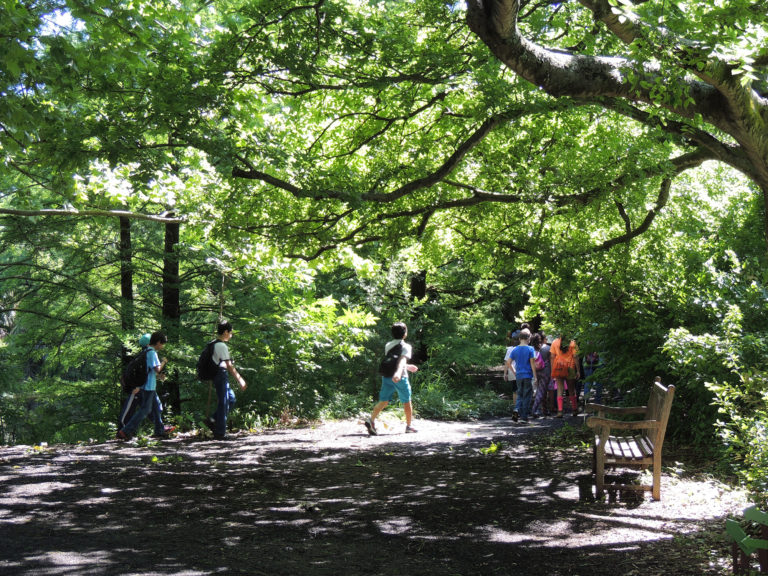
A unique aspect of the San Antonio Botanical Garden, the Texas Native Trail gives guests the chance to walk across Texas. The trail features three distinctive and diverse ecological regions of Texas: the Hill Country (Edwards Plateau), East Texas Pineywoods, and South Texas. These three areas vary greatly in soil, topography and weather — which has resulted in the development of very separate plant life communities. The authentic botanical setting is enhanced by several early Texas houses, which have been reconstructed on the site to help illustrate and interpret the regional themes. Hit the trail to enjoy this one-of-a-kind experience.
Highlights of each area include:
- East Texas Pineywoods: 5,000 cubic yards of sandy loam transformed this former quarry site into a peaceful lake setting with towering pine trees and hardwoods, all accustomed to the acidic soils of East Texas. This portion of the trail winds around a one-acre lake with a one-room loblolly pine cabin (c 1850) from Post, TX (near LaGrange). The wraparound porch is a favorite spot of Botanical Garden guests to stop and soak up the scenery. A garden plot, barn and smokehouse complete the homestead setting.
- Hill Country: A limestone spring (or seep) tells the story of the Edwards Aquifer and its recharge, part of the critically important story of water in San Antonio. Plant life here includes live oaks, juniper, Texas mountain laurel, Eve’s necklace, Blanco crabapple, Possum Haw, Hop-tree, Uvalde maples and other limestone tolerant plants, plus a meadow of native grasses, wildflowers and cacti. This section of the trail also features both the 1840s Schumacher House and the 1880s Auld House. The Schumacher House has a fachwerk structure (sticks and mud like wattle and daub), demonstrating the use of native materials to provide housing. With each room added, note the progression of building skills as these pioneers adapted to their Hill Country setting. The Auld House was reputed to be the largest pinon pine cabin in the state. It was constructed from a historic stand of pinon pines harvested from the bluff above the home’s setting.
- South Texas Plains: Huisache, mesquite and cacti abound in this more arid region of Texas, while an adobe house illustrates the type of architecture familiar to South Texas. The Bird Watch is also located at the far end of this trail, where you can catch migrating birds feasting on native plants as well as citrus and peanut butter, thanks to volunteer efforts. More than 200 species of birds have been sighted at the Botanical Garden making it a favorite destination among birders, especially those new to the pastime.
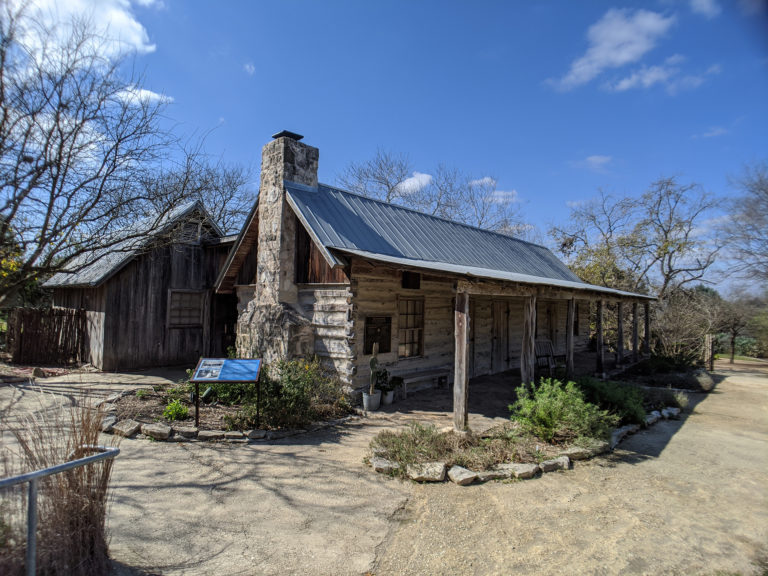
Located on the 11-acre Texas Native Trail, the Auld House was the 1880s family homestead of the Alexander Kennedy Auld Family. The piñon pine log cabin was built by this Texas pioneer family along “The Divide,” the highest point of the Edwards Plateau. Located near Leakey in Real County, the 14’ x 47’ structure is thought to be the largest piñon pine cabin in Texas. It was constructed of large-trunked logs from an archaic stand of piñon trees (dating from the Ice Age) on a ridge on the Auld Ranch.
Dan Auld, who bequeathed the cabin to the Botanical Garden, recalled the process of building the home:
“My father and a group of young Scotchmen cut these piñon logs for this home up on top of one of the hills on the ranch, carried them to the valley, put them on ox carts, and carried them to the present location.”
This Auld forebear was killed when he fell from his horse and was dragged to death. His widow, Susanna Lowrance Gibbens Auld, stayed on the remote ranch and raised seven children by herself.
The house itself was ideally situated, located on the protected base of a 300-foot cliff where a natural spring and fern bank had formed. Mrs. Auld kept milk, butter, and eggs in a cool niche above the spring. Comanche Indians, who had long used the cliff site as a campground would still come to camp there. On horseback, they would peer down at the Auld Homestead but never bother the widow or her children.
In 1996, the daughter of Dan Auld, Joan Auld Powell Hallmark, acted on her late father’s bequest of the homestead to the Botanical Garden. Botanical Garden’s board member, Cecil Jackson, whose avocation was log cabin restoration, proudly guided the reconstruction of the cabin at the Botanical Garden. It was just the type of early Texas architecture that founders of the Botanical Garden had in mind when they planned to have structures representing Texas’ geographic diversity in the 11-acre Texas Native Trail.
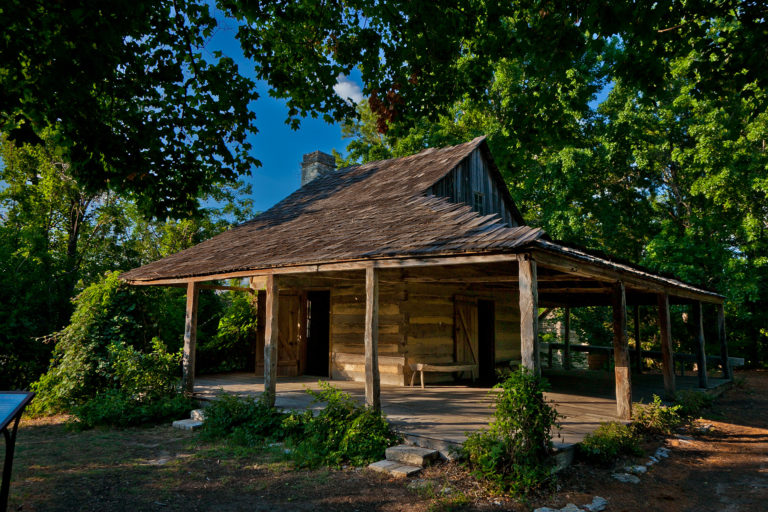
Settlers in East Texas, where rainfall is plentiful (up to 58 inches per year), used the abundance of large trees to make their homes. The East Texas Pineywoods are located on the edge of the vast pine-hardwood forest that extends over the Southeastern United States. The size of the pines in East Texas often meant larger log homes than in other parts of the state.
This authentic, hand-hewn post oak log cabin from Fayette County, built in the 1850s, sits at the lake’s edge on the Texas Native Trail. The cabin — representative of East Texas pioneer life at the time — is accompanied by the barn, smokehouse and wellhead from its original site in Park, TX (near La Grange). Its deeply shaded wraparound porch provided ample protected space for the daily needs of pioneer life. Inside, the house consists of one room with a fireplace and a high ceiling. Evidence of a loft also remains.
With no stores around the corner, pioneer homesteads like this one relied on the nearby kitchen garden to spice up meals of farm-raised pork or fresh game. Women were usually the ones to care for the small kitchen garden that provided fresh vegetables, herbs and fruit for the family, while men tended farm crops of corn, cotton and beans.
When moved to the Botanical Garden, all buildings were carefully indexed, dismantled, relocated and reconstructed in an ecologically accurate setting to illustrate the early Texans’ dependence on native vegetation.
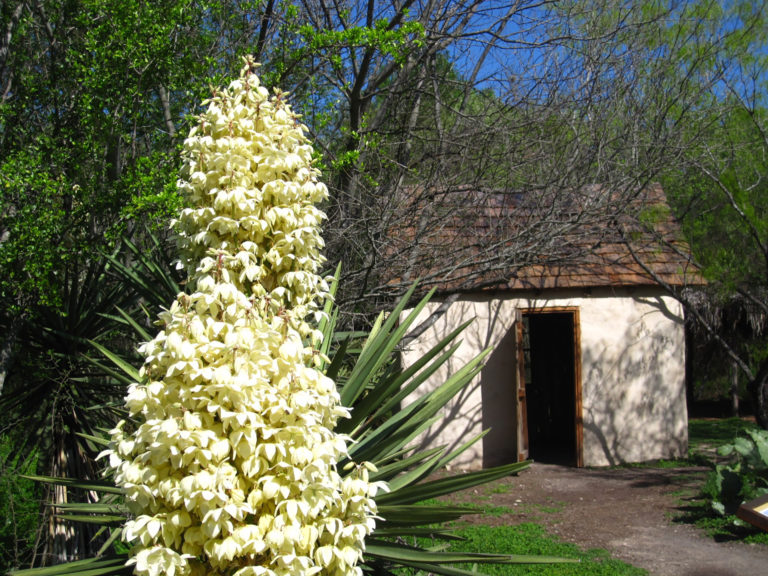
Originally built in the 1880s on the semi-arid South Texas Plains, this adobe structure is a palisado with a split shake roof. Inside, sections of wall space have been left open to illustrate the various techniques and materials used in typical adobe construction.
Inside, sections of wall space have been left open to illustrate the various techniques and materials used in characteristic adobe construction. Closely set vertical logs beneath a layer of mud or adobe form the walls. Settlers used readily available cedar posts, mud and the hot sun to create adobe structures. When the house was reassembled in San Antonio, cedar posts that were more than 100 years old were used in the reconstruction. The posts came from an old house on Culebra Road that was similar in structure. It’s also interesting to note that San Antonio is the farthest north that adobe is found; rainfall levels any farther north would literally melt the clay mud.
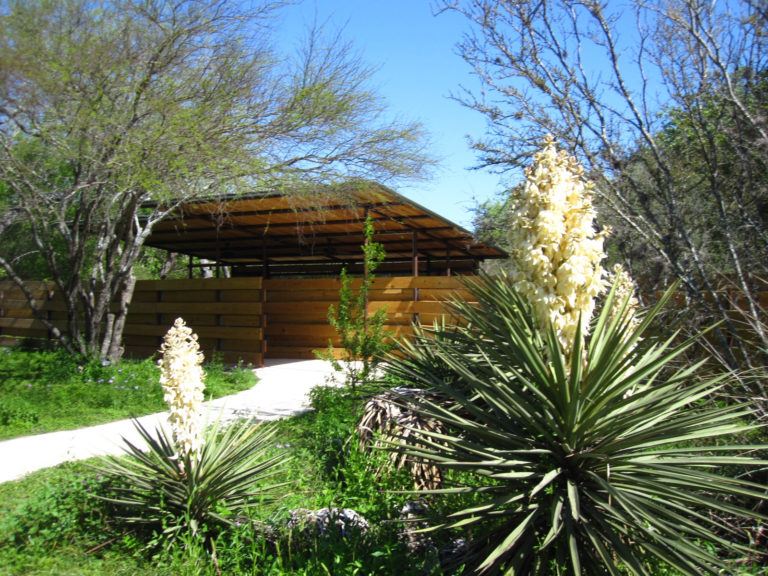
BIRDS IN THE GARDEN
As one of San Antonio’s prime birding hotspots, 255+ species have been reported in eBird for the Botanical Garden. San Antonio (Bexar County) is uniquely located at the confluence of the Edwards Plateau (the Hill Country) on the north, the Blackland Prairie and Post Oak Savannah to the east, and the South Texas Plains to the south, so a wide variety of bird species are attracted whether year-round, seasonal, or stopping while migrating through. Located in the Central Flyway, Texas is the second birdiest state with 675 reported species on eBird. As to the reported species spotted at the Botanical Garden, 223 are year-round Bexar County residents, 176 spend the winter in the county then head north for breeding season, 115 spend the warmer breeding season in the county then migrate south for the winter, and the remaining 161 reported species are seasonal migrating species stopping for a rest or feeding break during their migration in either direction. Currently, the Botanical Garden is one of the top Botanical Gardens in the country for reported species on eBird.
View our birding checklist or the eBird reports for the latest sightings in the Botanical Garden.
THE BIRD WATCH
This one-room observatory, completed in 2010, sits in the South Texas portion of the Texas Native Trails. The Botanical Garden’s expanding native plant collection and its unique geographical setting attract birds. The Bird Watch with bench seating, viewing photography portholes, and fans is perfect for unobtrusive bird watching and allows glimpses of birdlife up close and personal. Fed by a roof cistern collecting rainwater, the shallow trough beckons feathered guests with the sound of dripping water just deep enough for wading, taking a long cool sip, or lingering for a refreshing splash.
Native plants that complement the setting are curated for the seasons. Maximilian sunflowers and salvia might be seen in summer. In the cooler months, berry-producing selections such as Barbados cherry, Turk’s cap, possumhaw, and yaupon holly provide food and shelter The Texas ebony is a favorite of the Long-billed Thrasher, a year-round resident in the Garden, primarily in the South Texas section. Additional plants that are at our bird watch and are sought out by birds include skeleton-leaf goldeneye and inland sea oats. Bird Watch visitors can potentially spot multiple South Texas species such as Carolina Wrens, Couch’s Kingbirds, and Downy Woodpeckers throughout the year; Ruby-crowned Kinglets and White-throated Sparrows in the cooler months; and Black-chinned Hummingbirds, Great Crested Flycatchers, and Painted Buntings in the warmer months.
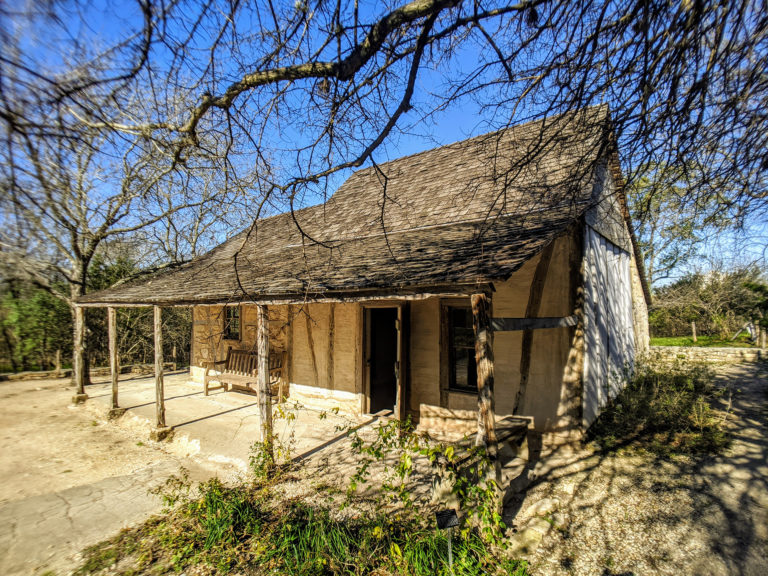
One of Fredericksburg’s earliest settlers, tailor Friedrich Wilhelm Schumacher, built this limestone and fachwerk home in 1849 in Fredericksburg, TX (on Austin Street).
Schumacher, born in 1815, was one of the earliest settlers in the area. His first concern on arrival was to build a home for his wife and two young children. The building materials used in the house graphically demonstrate the use of materials close at hand to the first settlers. With each subsequent addition of a room (three rooms total), construction techniques advanced. The first room utilizes post oak beams and a mixture of red clay, grass and woven willow branches from a nearby creek for filler support. Vertical, horizontal and slanting beams were held together with wooden pegs in this fachwerk construction. A second room, elevated one step from the original room is made from post oak beams, rock infill and crude mortar. Sections of wall space in the first two rooms reveal the underlying structure. At the rear of the house, the third room is made from quarried limestone, abundant in the Texas Hill Country. As the architecture evolves, handhewn beams advance later to sawed beams.
The simple plantings of an early German homestead complete the setting of the Schumacher House. To reach the Botanical Garden, the structure was disassembled, indexed and re-assembled on site.
The restoration of the Schumacher House by the San Antonio Botanical Garden won a 2006 preservation award from the San Antonio Conservation Society.
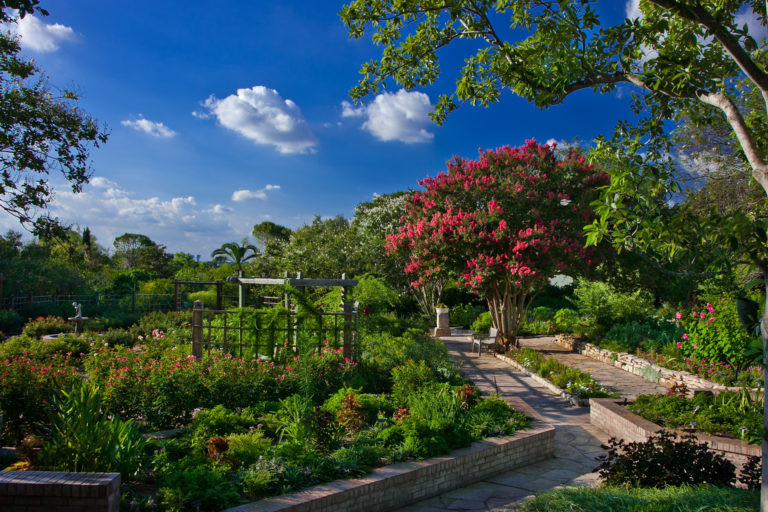
Opened in 1980, the oldest section of the Botanical Garden contains a series of formal and specialty gardens featuring brick-bordered beds. In the Old-Fashioned Garden — an Official Monarch Waystation — browse and reacquaint yourself with older flower varieties popular in eras past. Savor sweet fragrances in the Rose Garden. Experience the peaceful beauty of the Sacred Garden, Shade Garden, Gertie’s Garden and other garden displays like the Herb Garden, tended by volunteers. The wondrously colorful Cactus and Succulent Garden is located on the hillside next to the Children’s Vegetable Garden — don’t miss seeing this exceptional collection of desert plants.
Engage your senses of touch and smell in the Sensory Garden, which grows plants with interesting textures and scents. Braille signage as well as sculptures in ceramic and bronze also appeal to the sense of touch. For a diverse and ever-changing showcase for texture, color and fragrance, visit the Mays Family Display Garden. Nearby, the Kumamoto En Japanese Garden, a gift to San Antonio by its sister city, Kumamoto, was designed by landscape artists and craftsmen from Japan. It is a haven of rustic simplicity and peace amid stone walks, ponds and bamboo fences.
The Botanical Garden’s formal beds are comprised of four large rectangular display areas that are changed seasonally to display a variety of fun colors and textures. Sometimes subdued, sometimes exuberant, sometimes humorous, these changing displays are always worth checking out.
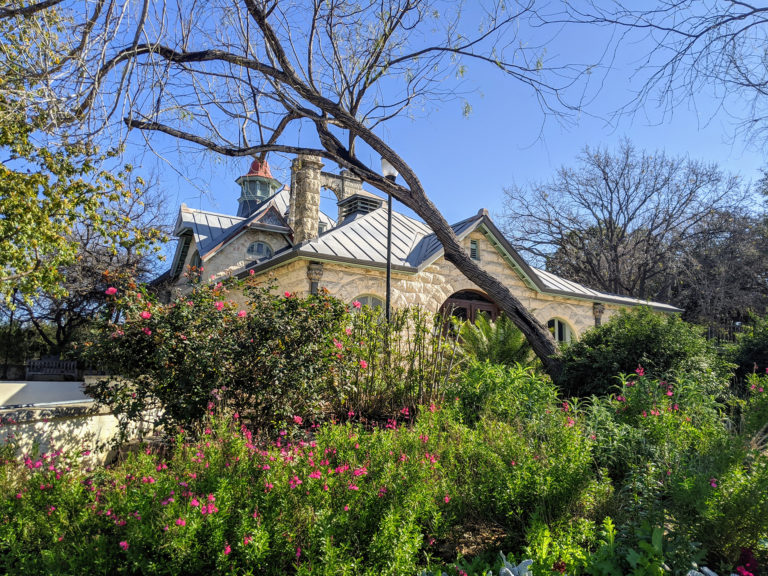
The Daniel Sullivan Carriage House was built in 1896 for one of the most colorful figures of early Texas, Daniel J. Sullivan. A superb example of the round-arched Richardsonian Romanesque style, the Daniel Sullivan Carriage House is a step back in history so real you can almost hear the wooden wheels and horse hooves.
An Irish immigrant, Sullivan served in the Texas Cavalry, 1st Regiment, during the Civil War. In 1882, he founded D. Sullivan & Co. Private Bankers, whose loans made possible the legendary cattle drives of the 19th century. Sullivan commissioned Alfred Giles, an English immigrant who moved to San Antonio in 1873, to design the coach house and stables built behind Sullivan’s home at Fourth and Broadway. Giles not only produced these beautiful, classic structures, but quickly established himself as the region’s most noted architect with many buildings to his credit in Texas and northern Mexico.
After Daniel Sullivan’s death, one of his daughters, Mary Elizabeth, and her husband, Major General John Lincoln Clem, resided in the home. Years earlier, in 1861, a nine-year-old Clem attempted to enlist in the Union Army. Rejected because of his youth, he attached himself unofficially to the 22nd Michigan Infantry and participated in the Battle of Shiloh as a drummer, for which he received notoriety as the Drummer Boy of Shiloh.
In 1987, the San Antonio Botanical Garden was offered the Carriage House with one stipulation – it must be moved within three months. With major support from the San Antonio Conservation Society that challenging goal was achieved. The Carriage House was completely disassembled by skilled stonemasons who cleaned and marked each limestone block. After a careful move to its new location at the Botanical Garden, the building was painstakingly reassembled stone by stone. In 1995, after several years of careful restoration, this beloved San Antonio historical building was opened and served as the entry to the Botanical Garden until 2019.

